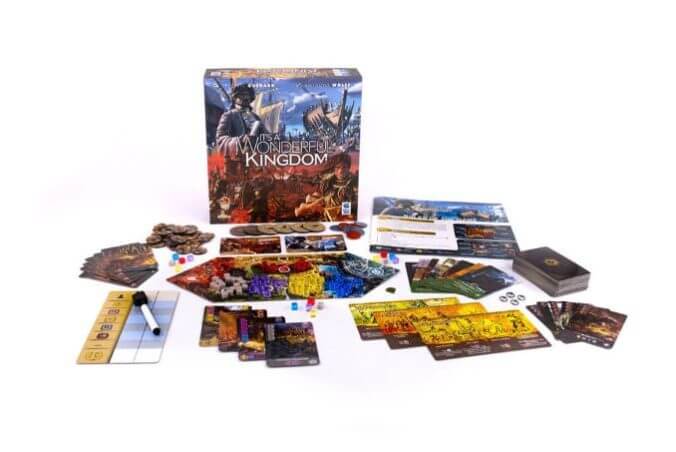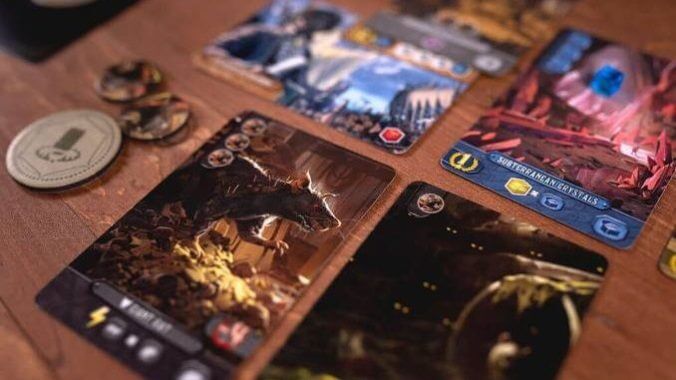It’s a Wonderful World came out in 2019 and, at least to my knowledge, got lost in the pandemic’s first year, only breaking out in 2021 as conventions ramped back up and people were playing more games together. It’s crept all the way up into the top 150 on Board Game Geek’s user-generated rankings of every game, like, ever, and keeps rising. One of the few criticisms of the game is that there’s almost no player interaction—the sort of game derided as “competitive solitaire”—so the designer brought out a new version, It’s a Wonderful Kingdom, late in 2022, which is for either two players or as a solo game, and in two-player mode, you are definitely fighting your opponent. I think it loses some of what makes the original game so good, unfortunately.
It’s a Wonderful World is sort of a mashup of Race for the Galaxy and 7 Wonders, with a little more resource management involved. Each player gets a unique start card that provides a few resource cubes at the start of every round and a game-end points bonus based on what you’ve built. In each round, you receive a hand of seven cards, pick one to keep, and pass the remainder to your neighbor (what’s known as “card drafting”). You get a new hand from your neighbor on the other side, pick a card, and pass the rest. Once all cards have been selected by players, then you move to the next phase, where you decide which cards to build and which to ‘recycle’ for resources. Building cards requires two to eight resource cubes, with five different colors of such resources. Some cards produce resources in future rounds when you build them, and some are worth victory points at game end. Some do both. All cards are worth a single cube of a specific color if you recycle them. So in each round, you try to align your production and recycling with your building needs to get the highest possible score at the end of four rounds. There’s only one way in which you compete directly with your opponents before the final scoring, as there’s a small bonus after each round for the player who produces the most of each of the five main resource types.
There are two catches with resource production in both of these games. One is that you can’t save resources from round to round—if you produce something, or get it via recycling, you have to put it on a building that needs it, or else you send it to the “empire,” where it sits, taunting you, until you collect five cubes there and get a red wild cube instead. The other is that production is sequential, with each color producing in a set order, so you might get enough cubes of one color to finish a card that produces cubes of another color, and then be able to use that card in the same round.

It’s a Wonderful Kingdom has the same core mechanics of card-drafting, choosing between building/recycling, and aligning production with building needs. The original does have a slight tweak for two players, where you each start with a ten-card hand and draft until each player has played seven, but Kingdom goes well beyond that. Its biggest change is in the card-drafting round—the start player for that round places two cards from their hand on the table for the other player to choose from, putting one on each side of the central board or both on one side. The other player then chooses one side or the other, places two more cards down from their hand, and so on. In each round, each player has two Trap tokens they can use to place a card face-down rather than face-up, so they can mask the real value of a set of cards and try to decoy the other player. This is a matter of personal preference, but I can’t stand this mechanic—it’s just straight-up guesswork on the part of the other player, with no deduction involved—and I haven’t loved it in other games that used it either, like the light card-drafting game Sundae School.
It’s a Wonderful Kingdom also comes with three modules you can use to alter game play by introducing cards that have some sort of negative value. (The rules say you have to choose a module, but the game is fully playable without one.) The most combative is the Menace module, which reminds me a bit of Riftforce, as each player picks a Menace deck and adds one card from that deck to their hand in each round. If you end up taking a Menace card, it goes into your area and can prevent you from adding to a building, or makes you produce one fewer resource, or just deducts points from your score, depending on the type. The Advisors module shuffles helpful Advisor cards that give you unique abilities you can access by spending the Soldier tokens you get from certain cards. The Quest module is just like building a Wonder in 7 Wonders, as you must go through several steps, in order, and gain some benefit for each step you complete. Some modules also use Calamity cards that just cost you points and that get shuffled into the main deck as well.
Both games have similar artwork, which I find very busy, with a theme that doesn’t have much to do with the game play—which, at least in the original, is very simple, elegant, and kind of easy to learn. If you haven’t played either of these games, I’d strongly recommend It’s a Wonderful World, even if you primarily play with just two players. (I’d give that game a 9 on Paste’s rating scale.) If you’ve played that game and specifically want something that involves some tit-for-tat, or you want what amounts to a trio of expansions to the original that are tailored to two-player games, then It’s a Wonderful Kingdom is worth picking up.
Keith Law is the author of The Inside Game and Smart Baseball and a senior baseball writer for The Athletic. You can find his personal blog the dish, covering games, literature, and more, at meadowparty.com/blog.

